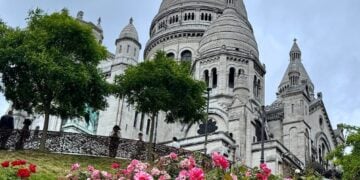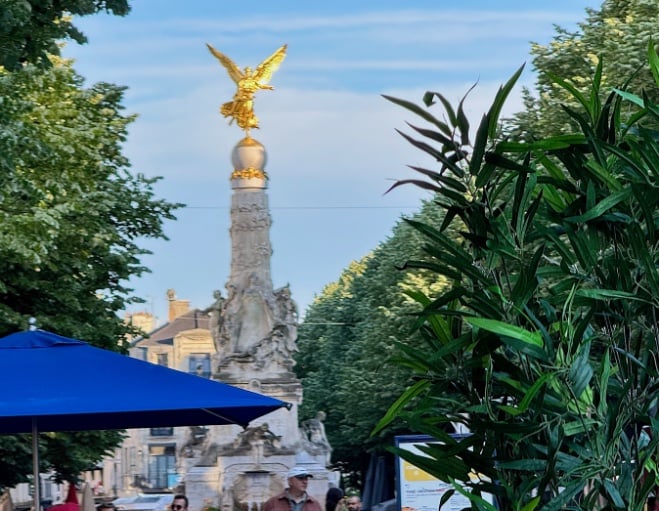Fabulous Reims, Less Than an Hour from Paris
The third leg of our of our European trip brought us from Amsterdam to Germany to Reims, located in the heart of the Champagne wine region of France. Reims is home to many of the world’s top champagne houses, including Lanson, Mumm, Veuve Clicquot, Taittinger, Ruinart, and Pommery. It is also home to the spectacular Reims Cathedral and the Romanesque Saint-Remi Basilica, both UNESCO sites. We arrived by train from Frankfurt, but many visitors arrive on a 45-minute high speed train ride from Paris. We finished our European adventure in Epernay and Paris.
Julie and I were in Reims four nights and three full days. Each full day we visited one Champagne house in the morning and one in the afternoon. The Champagne Houses we visited included Lanson, Mumm, Veuve Clicquot, Taittinger, Ruinart, and Pommery. We also visited several fabulous restaurants, including Michelin starred Arbane Restaurant and Le Jardin Brasserie at Les Crayeres, holder of the Bib Gourmand distinction. We also had a wonderful dinner of chicken kebabs and salads at the casual L’ Istanbul near our bnb.
Michelin Starred Arbane Restaurant with Chef Mille
We were fortunate to be hosted for lunch at Chef Philippe Mille’s fabulous Michelin starred restaurant, Arbane. Just a few minute’s walk from our bnb, this popular restaurant is housed in a beautiful 1874 former mansion. The rear terraced seating area is nestled in an oasis of green trees and grasses along with colorful flowers, a peaceful respite from the surrounding hustle and bustle of Reims.
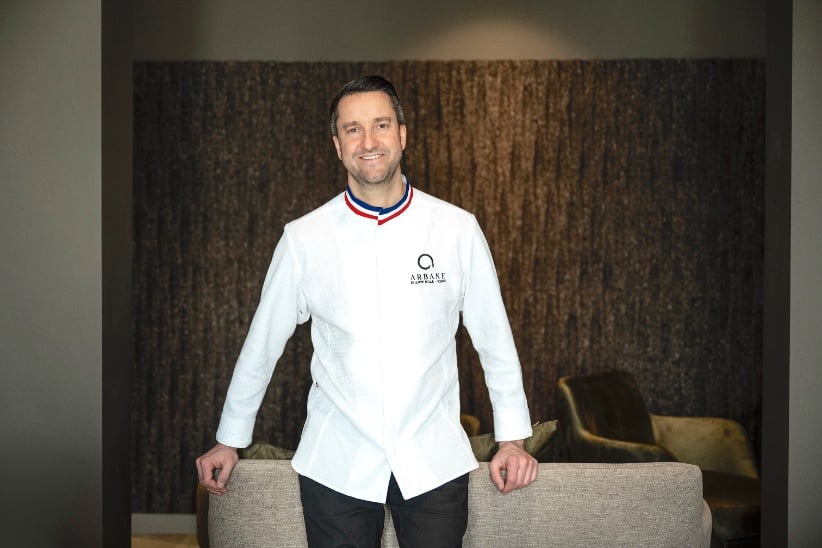
Arbane is the brainchild and passion project of Chef Mille, and after just a year since opening, is the number one restaurant in Reims according to many critics and guides. During our fabulous meal, Chef Mille came into the dining room to speak to each guest. Julie and I enjoyed our brief but gracious conversation with him. It is always a pleasure to meet a person so friendly, genuine, and gifted.
The tasting menu with thoughtful champagne pairings was outstanding from beginning to end. Starting with appetizers and champagne on the terrace, the professional and very friendly staff made us feel relaxed and welcome. Our first glass of champagne was a crisp Matthieu Godme-Guillaume, followed by our starters – flavorful amuse-bouches – of goat cheese mouse with spinach and lentils with champagne jelly. After ensuring we were done with our starters and our second glass of champagne – a tasty Les 7 Laherte Freres – we were escorted into the elegant dining room. Our table by the window had a wonderful view of the terrace as well as a great view of the dining area.
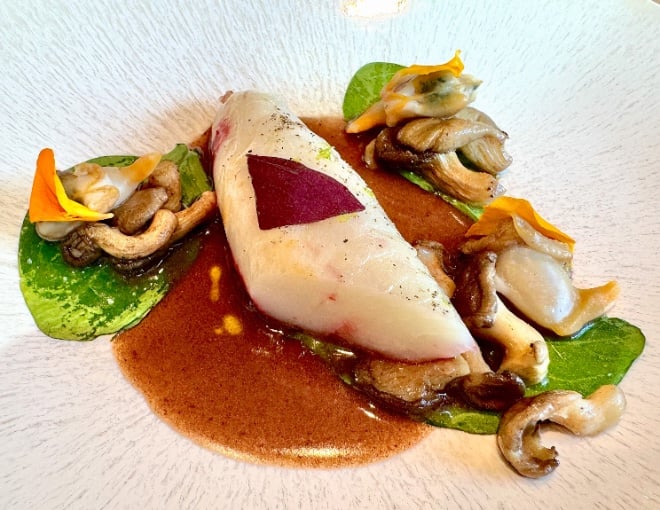
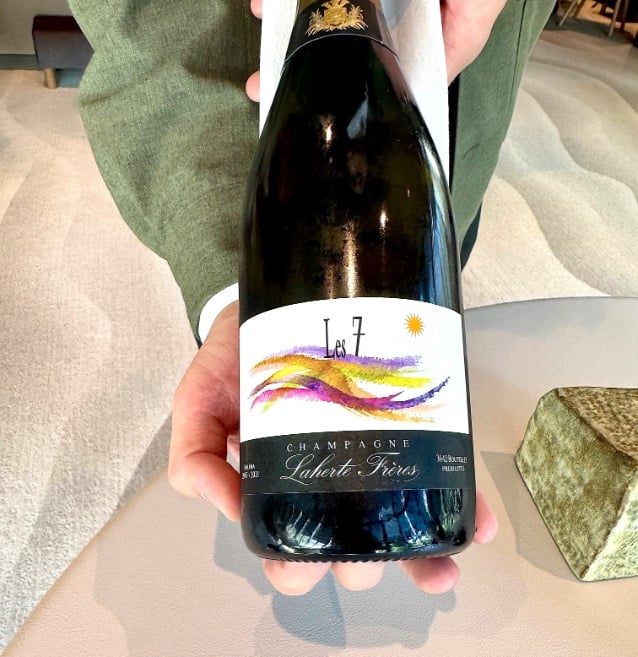
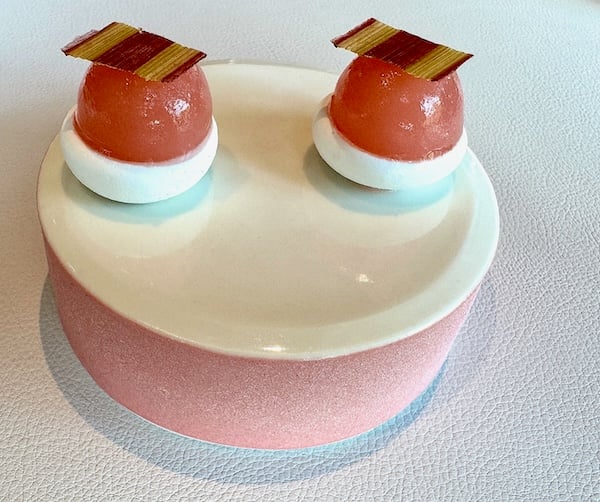
Chef Mille is one of those gifted chefs who combines an intimate knowledge of local ingredients to create special culinary delights. Each dish is artistically presented and full of flavor, each designed to delight with your eyes, nose, and mouth. Chef Mille honed his skills at several other well know restaurants, including earning a Michelin Star during his years as Executive Chef at Les Crayeres’ Le Parc and Le Jardin Brasserie.
There were so many great dishes, it’s hard to pick a favorite. One that I loved is one of Mille’s masterpieces, “Le Vitrail” – Rosace à la Cathédrale, a stunning homage to Reims Cathedral’s rose window. The base is made of mousseline of seasonal vegetables (cauliflower or celery) with a center of thick langoustine carpaccio, marinated in verjus. The dish is accented with orange-red langoustine bisque, pale-yellow citrus condiment, a maize tuile, and edible gold leaf – a true work of art.

The cheese cart was full of tasty treats. Offered as an optional supplement, the “chariot de fromages de nos terroirs” presents a curated selection of local and regional cheeses. Some of the cheeses include Camembert, Chaource, Cantal, Roquefort, and local Argonne goat from the Laluc family.
If you get a chance to dine at Arbane, do it! You’ll be glad you did.
Champagne Houses in Reims
With its prominent location in the heart of Champagne’s wine country, it is no surprise that Reims is home to some of the most prestigious Champagne Houses. We were fortunate to visit six top houses in Reims for tours and tastings: Lanson, Mumm, Veuve Clicquot, Taittinger, Ruinart, and Pommery. Following Reims we also visited the Champagne Houses of Alfred Gratien, Jacquinot, Moet-Chandon, Perrier-Joulet, and Mercier in nearby Epernay.
Lanson Champagne House
Located at 66 Rue de Courlancy, in the southwest area of the city, Lanson is about a 20 minute walk from Reims Cathedral. Founded in 1760, it is one of the oldest Champagne houses in Reims. Lanson is known for its non-malolactic fermentation style, which gives Lanson Champagnes a fresher, crisper, and longer-aging profile. We enjoyed our tour along with our small international group of visitors, a diverse group from Germany, Puerto Rico, London, New York, Australia, and Texas (Julie and me).
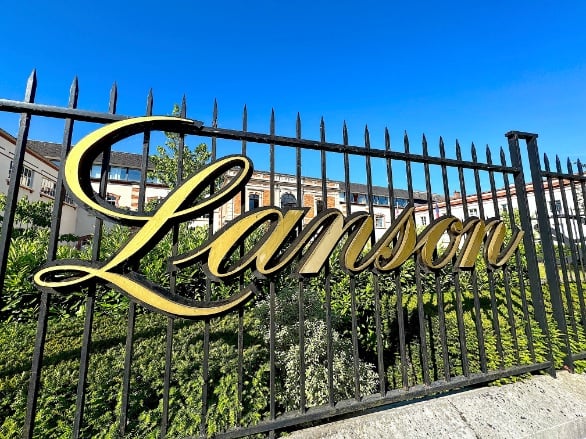

Lanson is one of the few Champagne Houses in the city to have a producing vineyard on property. As we learned from most of the Champagne Houses we visited, the primary grapes used at Lanson and others in Champagne are:
- Pinot Noir – gives power, structure, depth.
- Chardonnay – delivers freshness, finesse, and aging potential.
- Pinot Meunier – adds fruitiness and charm in youth.
As a former tennis coach in Texas, I was intrigued by the long-standing relationship between Lanson and the Wimbledon Championships held each summer in London. Maison Lanson has supplied this prestigious tournament since 1977 and became the Official Champagne Partner in 2001. A staggering 150,000 glasses of Lanson champagne are served each year at the Championships.
Mumm Champagne House
Founded in 1827 by the Mumm brothers (Jacobus, Gottlieb, and Philipp) of Germany, Mumm Champagne House is located at 34 Rue du Champ de Mars in Reims. Mumm bottles are easily recognized by the famous red sash (“Cordon Rouge”) that honors the red ribbon of the French Legion of Honor. They have been longtime suppliers to European royal courts, and are known for precision, structure, and vibrant acidity.
One of the many highlights of Mumm include the 25 km of underground chalk cellars. Everywhere you turn at this Reims’ UNESCO World Heritage site you are reminded of the Mumm motto: “Only the best.” Mumm owns around 218 hectares of vineyards, and 98% of vineyards are rated Grand Cru or Premier Cru, with key vineyard holdings in the Montagne de Reims and Côte des Blancs.
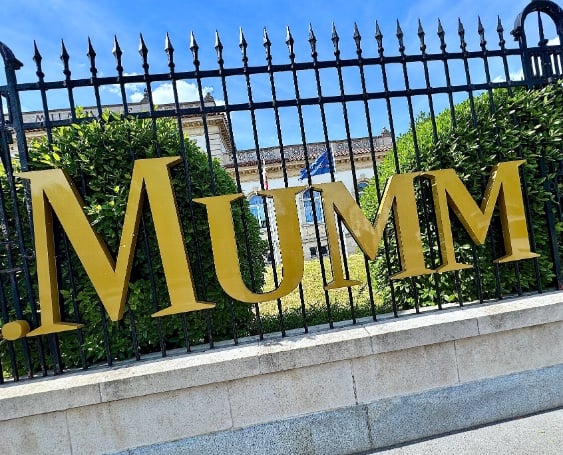
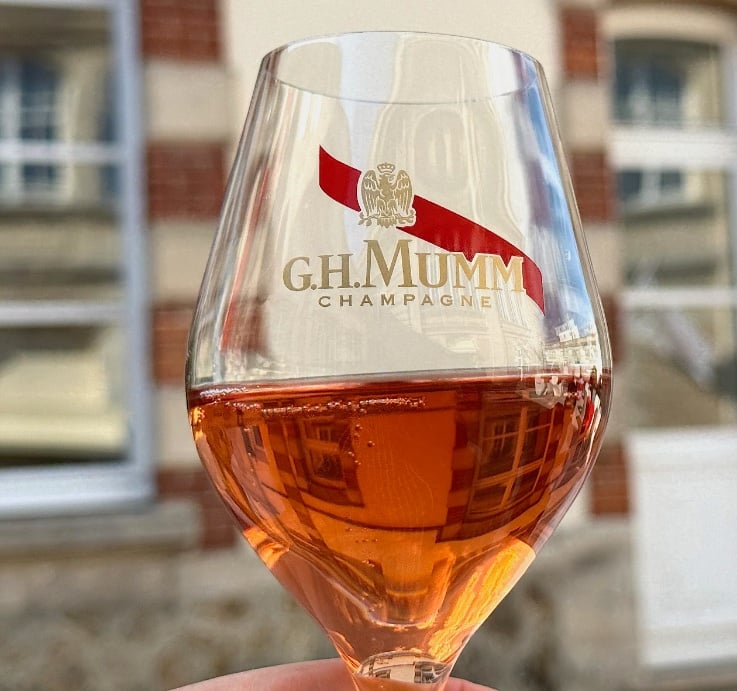
Veuve Clicquot Champagne House
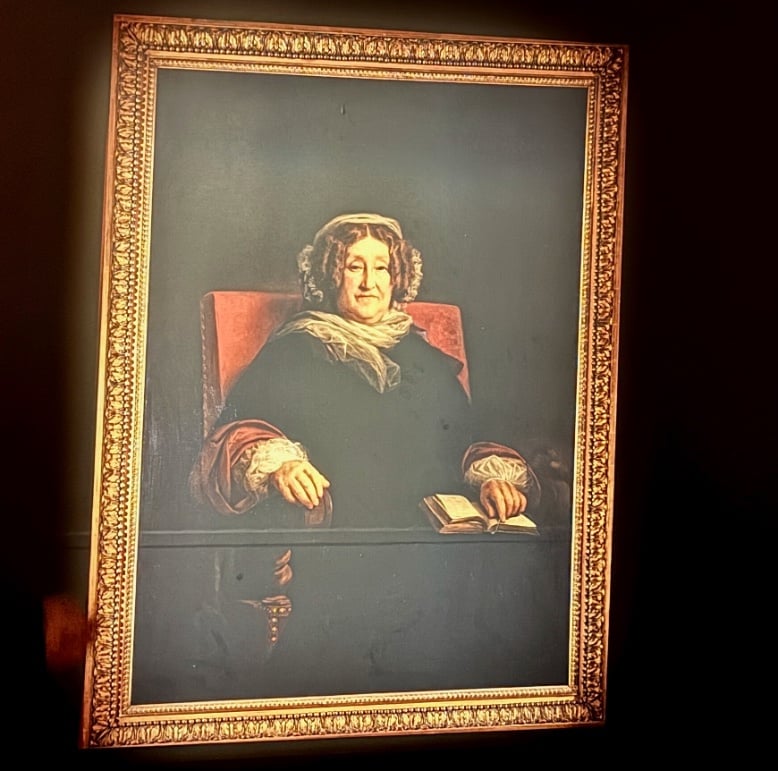
My son and his wife spent some time at Veuve Clicquot a few years ago and insisted we needed to go the next time we visited France. We loved their yellow label champagne, and were intrigued by its history as one of the first large international Champagne Houses. We learned about the visionary Widow Clicquot, who took the reins of Veuve Clicquot at the young age of 27 after the death of her husband. A woman in a man’s world, Barbe-Nicole Clicquot became a major force in the world of champagne throughout her long storied life. She exported Champagne even during the Napoleonic wars, famously sending bottles to Russia.
She is one of the most important women in wine history, often referred to as “La Grande Dame de la Champagne.” Some of the major innovations credited to Madame Clicquot include inventing the riddling table in 1808 to clarify Champagne efficiently and perfecting techniques that helped modernize Champagne production. Under her leadership, Madame Clicquot helped make Champagne a luxury export all over Europe. With 390 hectares (963 acres) and 24 km of tunnels, Veuve Clicquot is one of the largest and most influential Champagne Houses in France.
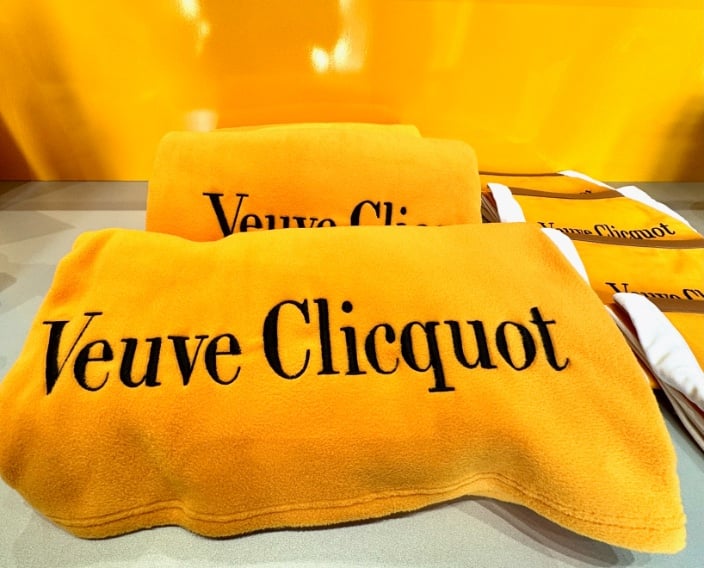

We also enjoyed lunch at the Veuve Clicquot Café. Yellow label Champagne paired with a Sunny Burger and fries on the outdoor terrace was the perfect way to complete our visit to Veuve Clicquot. We relaxed with our burger and fries, sipping on our champagne, and thought how lucky we were on this beautiful May afternoon.
Taittinger Champagne House
After our lovely time at Veuve Clicquot, we walked a short five minutes to Taittinger, another legendary name in Champagne. Originally founded in 1734 as Forest & Fourneaux, this Champagne House officially became Taittinger in 1932, when Pierre Taittinger acquired it. One thing unique about Taittinger is the fact that the headquarters at 9 Place Saint-Nicaise is on the grounds of the former Abbaye de Saint-Nicaise. Unfortunately, this historic abbey was largely destroyed during the French Revolution in the late 1700s.
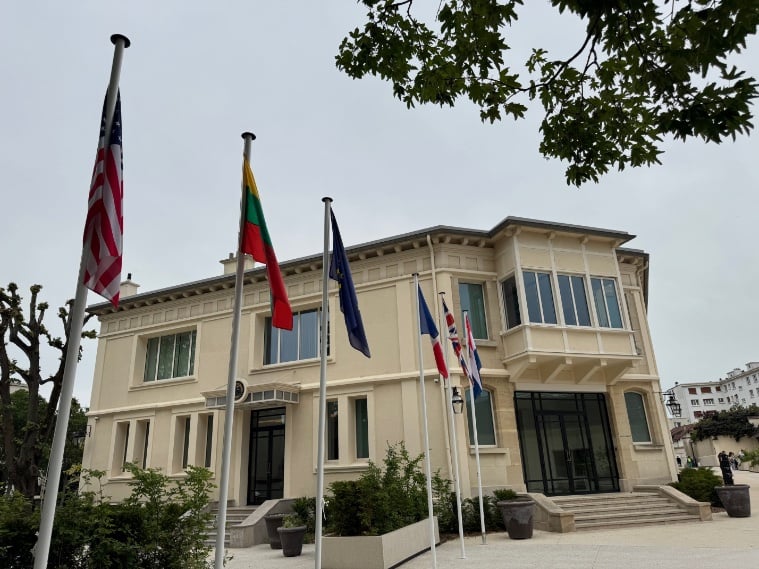
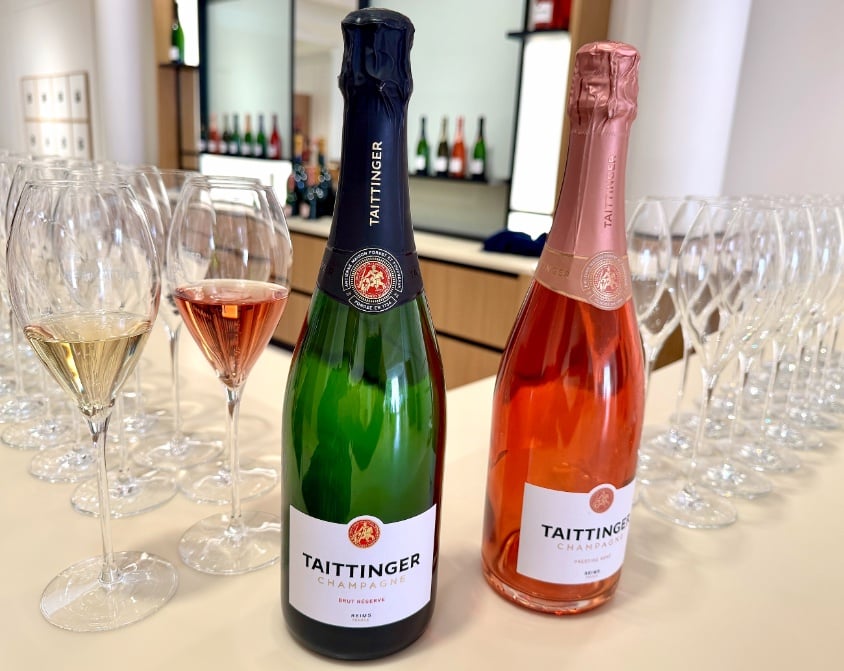
Beneath Taittinger headquarters are ancient Roman chalk quarries. These unique cellars are some of the oldest in Reims, descending 18 meters below the surface. A portion of the tour includes these ancient chalk tunnels and caves, several with dramatic artwork. Taittinger is one of the few family-owned major Champagne houses, with Vitalie Taittinger running it since 2020 as CEO and President.
Ruinart Champagne House
Founded in 1729 by Nicolas Ruinart, Ruinart is the oldest Champagne House in France. Nicolas was inspired by his uncle, Dom Thierry Ruinart, a Benedictine monk who saw early potential in sparkling wine. Among its many achievements, in 1764 Ruinart introduced the world’s first rosé Champagne.

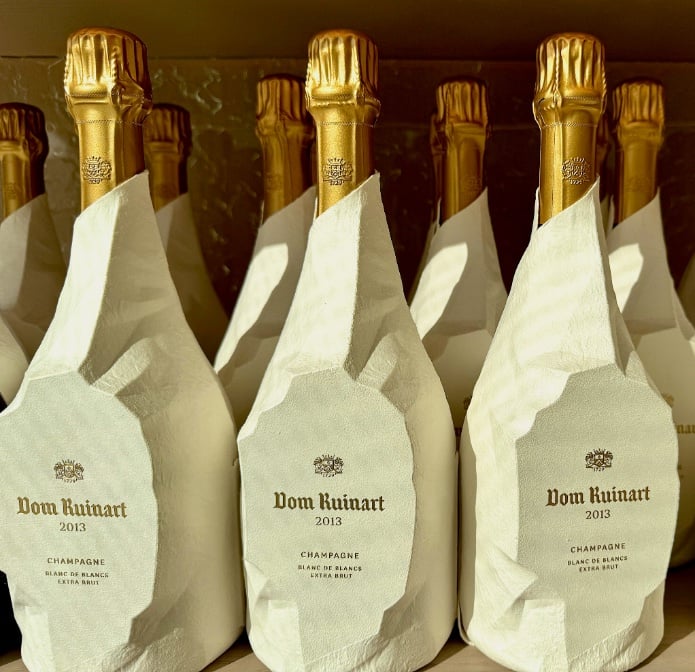
Recent renovations of the campus at 4 Rue des Crayères has created one of the most picturesque settings in Reims. The main curved buildings features ceiling to floor glass windows, featuring a scenic entry path and contemporary art installations by renowned architects and artists. I loved the artwork in the elegant tasting room, including an 1896 poster advertising the champagne.
The star of the show is Ruinart’s Blanc de Blancs. The classic clear, elegant bottle shape restored from 18th-century designs reads “Blanc de Blancs”, highlighting its 100% Chardonnay composition and its status as the epitome of Ruinart’s terroir-driven, refined style. Using only the white Chardonnay grape, the Blanc de Blancs have lighter, fresher, and more delicate flavors like citrus, white flowers, green apple, and minerality.
Pommery Champagne House
After five fabulous Champagne Houses in three days, we were ready for our last Champagne House in Reims before moving on to Epernay – Pommery. Pommery is known for, along with Taittinger, having the longest stairway down into its cellars. Pommery (116 steps) and Taittinger (118 steps) both go about 30 meters deep underground into the chalk caves and tunnels. Pommery’s stairway is often considered more visually dramatic because of the architecture, colorful illumination, and spacious landing.
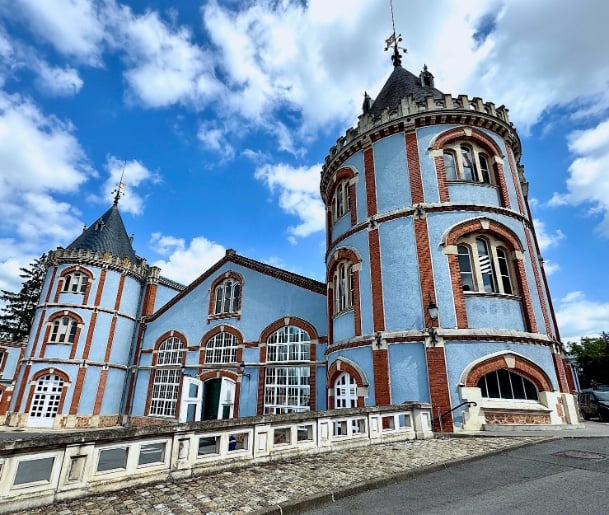
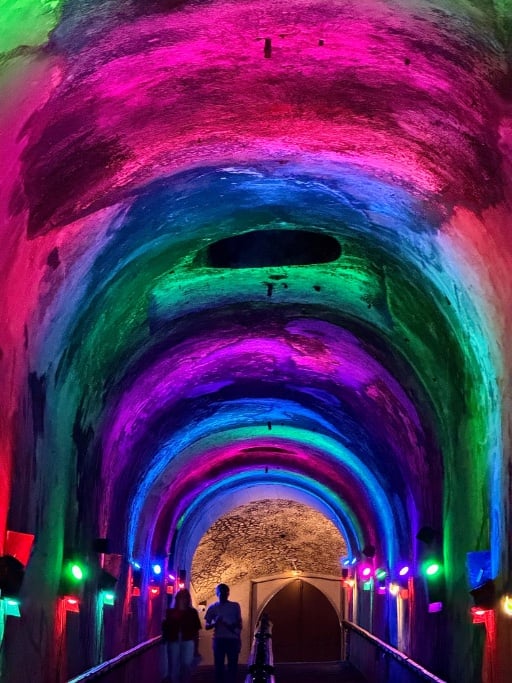
Pommery was founded in 1858 by Alexandre Louis Pommery and Narcisse Greno. Alexandre passed away in in 1860, and his wife took over the business. Like Veuve Clicquot, Pommery’s early development was led by an amazing creative, innovative woman after her husband passed. Madame Louise Pommery assumed leadership and initiated some major growth and expansion of Pommery.
Starting in 1868, Madame Pommery commissioned one of the largest construction project of the time. Going down 30 meters, Madame Pommery headed the conversion of 18 km of Gallo–Roman chalk quarries into vast cellars adorned with bas-relief sculptures by Gustave Navlet and others.
The Pommery tour included many unique art exhibits throughout the underground tunnels and caves. Historic Bas‑Reliefs by Gustave Navlet carved directly into the chalk walls are very impressive, and contemporary art installations are found throughout the tour. Many are unique and unexpected, reflecting a wide range of contemporary styles and themes. The lighting illuminating the long stairway into the cellars was really cool.

As part of our tour, we also had access to the Villa Demoiselle, just across the street from the main campus. Constructed in 1909, it was commissioned by Henri Vasnier, the director of Pommery. Villa Demoiselle was designed by architect Louis Sorel as a lavish reception home, and showcases a harmonious blend of Art Nouveau and Art Deco, with lots of original stained glass, ornate woodwork, murals, and other period décor.
Le Jardin Brasserrie at Les Crayeres
After our wonderful time at Ruinart in the morning, we were excited about our lunch reservations at nearby Le Jardin Brasserie at Domaine Les Crayeres, holder of a Bib Gourmand award. Ironically, Chef Philippe Mille from Arbane was the Executive Chef at Les Crayeres from 2009–Feb 2024, where he oversaw both Le Parc and the opening of Le Jardin in 2009. Chef Mille set the culinary tone across both venues, bringing fine-dining techniques and seasonal flair to the brasserie. Since March of 2024, that same tradition of excellence has been led by Chef Christophe Moret.
We entered from the beautiful terrace overlooking a large green park on the grounds of Les Crayeres. With a tasting at Ruinart in the morning and another tasting after lunch at Pommery, we passed on more champagne with lunch – even for great Champagne, we do have our limits! We both opted for the Menu Jardin, a three course prix fixe menu featuring a starter, main, and dessert.

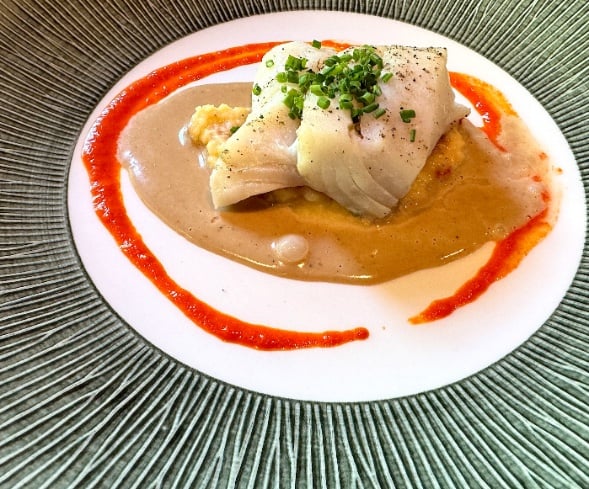
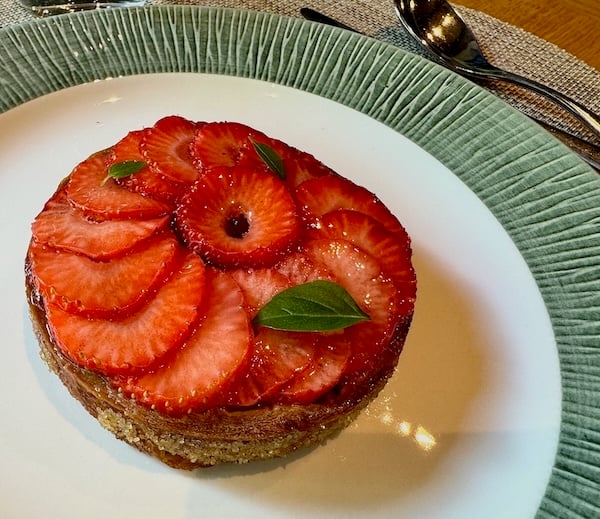
Julie started with Velouté d’asperges vertes (a green asparagus cream soup) while I ordered Mackerel with pickled vegetables in a cream sauce. For mains, we each ordered the tender Pollack – prepared simply to highlight its delicate texture. This mild white fish was served with a zesty Thai-style sauce that gave it a fragrant, slightly spicy kick. Accompanied by fresh seasonal vegetables sourced locally, it was fresh and delicious.
We finished with a silky Indonesian Chocolate Pie and a tasty Strawberry and Mint torte – both were delicious. Service was friendly and professional, and the setting just the right mix of elegant and casual – a real treat! If your schedule permits it, Le Jardin Brasserie is a must for lunch or dinner in Reims.
Cathédrale Notre-Dame de Reims
For over 1,000 years, Reims was where French kings were crowned. The breathtaking Cathédrale Notre-Dame de Reims hosted the coronations of 25 French monarchs, including the famous crowning of Charles VII attended by Joan of Arc in 1429. The cathedral is a UNESCO World Heritage Site known for its stunning Gothic architecture and beautiful stained glass.


We walked a short 10 minutes from our bnb to this magnificent structure. The cathedral suffered massive damage during WWI, but was restored to its current state after years of rebuilding. Stunning strained glass windows, a spectacular altar, and soaring ceilings are just a few of the amazing sights in this historic cathedral. Another interesting feature inside the cathedral is the majestic clock housed within a beautifully carved wooden case featuring Gothic style with angelic figures. We were lucky to see animated figures of the clock perform when it chimed at 11:00 (see our video for the clock in action).
Fabulous Food, Champagne, and More in Reims
We arrived in Reims with excitement and high expectations. We could not ask for a better experience. The food, the champagne, the architecture, history, and the friendly folks were all amazing. Reims is a true treasure in this historic city just 45 minutes from Paris.
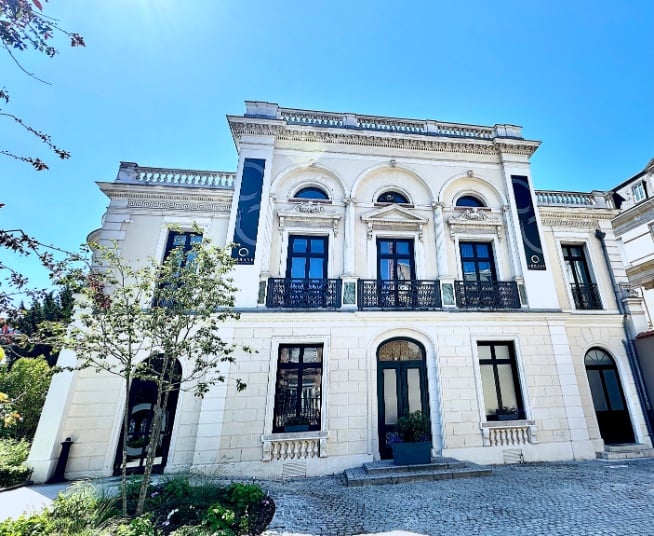
Many thanks to Arbane Restaurant, Lanson Champagne House, and Ruinart Champagne House for hosting us. All opinions are my own.










